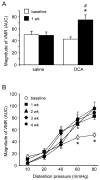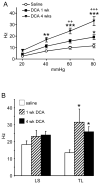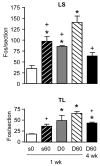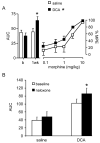A rat model of chronic postinflammatory visceral pain induced by deoxycholic acid
- PMID: 19000677
- PMCID: PMC2782449
- DOI: 10.1053/j.gastro.2008.08.051
A rat model of chronic postinflammatory visceral pain induced by deoxycholic acid
Abstract
Background & aims: Chronic visceral hyperalgesia is considered an important pathophysiologic symptom in irritable bowel syndrome (IBS); previous gastrointestinal inflammation is a potent etiologic factor for developing IBS. Although there are several animal models of adult visceral hypersensitivity after neonatal perturbation or acute colonic irritation/inflammation, current models of postinflammatory chronic visceral hyperalgesia are unsatisfactory. The aim of this study was to establish a model of chronic visceral hyperalgesia after colonic inflammation in the rat.
Methods: Deoxycholic acid (DCA) was instilled into the rat colon daily for 3 days and animals were tested for up to 4 weeks.
Results: DCA induced mild, transient colonic inflammation within 3 days that resolved within 3 weeks. An exaggerated visceromotor response, referred pain to mechanical stimulation, increased spinal Fos expression, and colonic afferent and dorsal horn neuron activity were apparent by 1 week and persisted for at least 4 weeks, indicating chronic dorsal horn hyperexcitability and visceral hyperalgesia. There was no spontaneous pain, based on open field behavior. There was a significant increase in opioid-receptor activity.
Conclusions: DCA induces mild, transient colitis, resulting in persistent visceral hyperalgesia and referred pain in rats, modeling some aspects of postinflammatory IBS.
Figures






Similar articles
-
TRPV1 sensitization mediates postinflammatory visceral pain following acute colitis.Am J Physiol Gastrointest Liver Physiol. 2015 Jul 15;309(2):G87-99. doi: 10.1152/ajpgi.00421.2014. Epub 2015 May 28. Am J Physiol Gastrointest Liver Physiol. 2015. PMID: 26021808
-
Elevated H2 O2 levels in trinitrobenzene sulfate-induced colitis rats contributes to visceral hyperalgesia through interaction with the transient receptor potential ankyrin 1 cation channel.J Gastroenterol Hepatol. 2016 Jun;31(6):1147-53. doi: 10.1111/jgh.13226. J Gastroenterol Hepatol. 2016. PMID: 26574143
-
The vanilloid receptor initiates and maintains colonic hypersensitivity induced by neonatal colon irritation in rats.Gastroenterology. 2007 Feb;132(2):615-27. doi: 10.1053/j.gastro.2006.11.014. Epub 2006 Nov 10. Gastroenterology. 2007. PMID: 17258716
-
Post-inflammatory modification of colonic afferent mechanosensitivity.Clin Exp Pharmacol Physiol. 2009 Oct;36(10):1034-40. doi: 10.1111/j.1440-1681.2009.05248.x. Epub 2009 Jun 29. Clin Exp Pharmacol Physiol. 2009. PMID: 19566823 Review.
-
Abdominal pain in Irritable Bowel Syndrome: a review of putative psychological, neural and neuro-immune mechanisms.Brain Behav Immun. 2011 Mar;25(3):386-94. doi: 10.1016/j.bbi.2010.11.010. Epub 2010 Nov 20. Brain Behav Immun. 2011. PMID: 21094682 Review.
Cited by
-
Gut microbial metabolite deoxycholic acid facilitates Th17 differentiation through modulating cholesterol biosynthesis and participates in high-fat diet-associated colonic inflammation.Cell Biosci. 2023 Oct 3;13(1):186. doi: 10.1186/s13578-023-01109-0. Cell Biosci. 2023. PMID: 37789469 Free PMC article.
-
Sex differences in visceral sensitivity and brain activity in a rat model of comorbid pain: a longitudinal study.Pain. 2024 Mar 1;165(3):698-706. doi: 10.1097/j.pain.0000000000003074. Epub 2023 Sep 27. Pain. 2024. PMID: 37756658 Free PMC article.
-
Microbial Metabolite Dysbiosis and Colorectal Cancer.Gut Liver. 2023 Mar 15;17(2):190-203. doi: 10.5009/gnl220260. Epub 2023 Jan 12. Gut Liver. 2023. PMID: 36632785 Free PMC article. Review.
-
Beneficial Effects of Limosilactobacillus fermentum in the DCA Experimental Model of Irritable Bowel Syndrome in Rats.Nutrients. 2022 Dec 21;15(1):24. doi: 10.3390/nu15010024. Nutrients. 2022. PMID: 36615683 Free PMC article.
-
Intestinal anti-inflammatory and visceral analgesic effects of a Serpylli herba extract in an experimental model of irritable bowel syndrome in rats.Front Pharmacol. 2022 Sep 2;13:967644. doi: 10.3389/fphar.2022.967644. eCollection 2022. Front Pharmacol. 2022. PMID: 36120292 Free PMC article.
References
-
- Rhodes DY, Wallace M. Post-infectious irritable bowel syndrome. Curr Gastroenterol Rep. 2006;8:327–332. - PubMed
-
- Price DD, Zhou Q, Moshiree B, Robinson ME, Verne GN. Peripheral and central contributions to hyperalgesia in irritable bowel syndrome. J Pain. 2006;7:529–535. - PubMed
-
- Bernstein CN, Niazi N, Robert M, Mertz H, Kodner A, Munakata J, Naliboff B, Mayer EA. Rectal afferent function in patients with inflammatory and functional intestinal disorders. Pain. 1996;66:151–161. - PubMed
-
- Lembo T, Munakata J, Mertz H, Niazi N, Kodner A, Nikas V, Mayer EA. Evidence for the hypersensitivity of lumbar splanchnic afferents in irritable bowel syndrome. Gastroenterology. 1994;107:1686–1696. - PubMed
-
- Parry S, Forgacs I. Intestinal infection and irritable bowel syndrome. Eur J Gastroenterol Hepatol. 2005;17:5–9. - PubMed
Publication types
MeSH terms
Substances
Grants and funding
LinkOut - more resources
Full Text Sources
Medical

